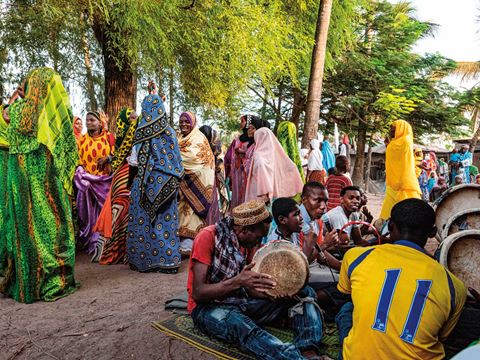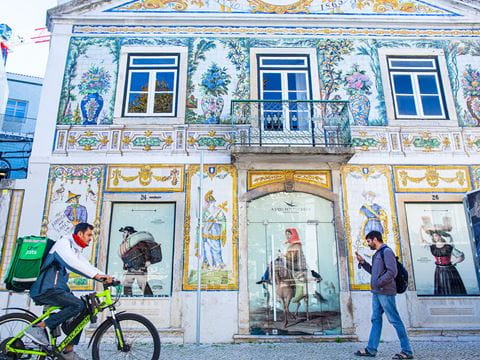
Berlin’s International Music Scene: A Study in Migration
Anthropology
Levant
North Africa
Europe
Explore what causes people to leave their homeland and to choose a specific place to settle, and how their presence affects that new place.
The following activities and abridged text build off “Berlin’s Transcultural Jam,” written by Ken Chitwood and photographed by Fabian Brennecke.
WARM UP
Before reading the article or doing the activities, scan the article’s photos and captions to predict the theme and main idea of the article.
IF YOU ONLY HAVE 15 MINUTES ...
Identify push and pull factors that contributed to migration from the Middle East and North African to Berlin and present them visually.
IF YOU ONLY HAVE 30 MINUTES ...
Determine how immigrants have changed Berlin, and write a persuasive paragraph that encourages visitors to come to the city.
VISUAL ANALYSIS
Before reading the article or doing the activities, scan the article’s photos and captions to predict the theme and main idea of the article.
Directions: As you read, you will notice certain words are highlighted. See if you can figure out what these words mean based on the context. Then click the word to see if you’re right.

Outside the famed Zig Zag Jazz Club in Berlin, Germany, it’s a cold and damp October night. Inside, the crowd is lively, chatting, and warm. The lights dim to a fire-red glow. Alas Zouiten and his bandmates take the stage. The Morocco-born musician begins plucking a few notes on his instrument’s strings. The crowd gets quiet.
Zouiten opens up the first song with a solo on the ‘ud, a stringed musical instrument similar to the lute. With fingers flying across the fretboard and his other hand quickly striking the strings, he showcases his virtuosity. The other band members join in with an even melodic beat. Zouiten tells the audience his band is playing different musical styles. The audience responds back enthusiastically. Zouiten explains that his music is a mix of flamenco arabe, urban jazz and Arab. In his band are a Spanish percussionist, a French bassist, a Canadian violinist and a Lebanese pianist. Like the city he now calls home, Zouiten is surrounded by a comingling of cultures. He says his music is about “transcultural enjoyment.”
Zouiten later explains that music in the Middle East, North Africa, and the Mediterranean is rich in tradition and diversity. This comes from diverse people who migrate in and out of the regions. In Morocco, for example, French and Arabic language is spoken independently and fused into a dialect. There is a complex blending of identities that present themselves in music.

Arabs are the fourth-largest ethnic group in Berlin, representing 3.5% of the total population. They first arrived in the 1970s, as guest workers, many from Morocco and Tunisia. Others came later from Lebanon, Palestine, Iraq, Sudan, and most recently—Syria. Many of these people were fleeing conflicts. For this reason, Berlin has become a polestar of music, influenced and performed by the new arrivals. Alongside the ethnically German majority, there is a mix of people, tones, rhythms, instruments and ideas. Berlin has become one of the world’s hottest crucibles of musical creativity. This multicultural blend of music is sweeping across Europe.
When Professor Amro Ali arrived in Berlin in 2011, he noticed a burgeoning Middle East cultural scene. The city was experiencing a rise in multicultural restaurants offering kebabs, shawarmas, baklava and more. He also noticed there was a lack of cultural institutions featuring Arab literature, art and music. But change was occurring. The Arab Spring in early 2011, was a series of anti-government protests and armed rebellions that spread across much of the Arab world. This forced many from North Africa, the Levant, and Syria to seek refuge and asylum abroad. Many fled to Germany.


In 2015 former German Chancellor Angela Merkel opened Germany’s doors even wider. Ultimately 1.2 million asylum seekers including writers, teachers, businesspeople, and intellectuals arrived in Germany. Many of these people came from the Middle East and North Africa and settled in Berlin. This created fertile ground for intellectual interactions and collaborations. The result was an unprecedented outburst of cultural activity. Soon, newspapers, plays, films, art shows and Arab libraries opened. Berlin became the city of choice for a new generation of Arab cultural talent.
Germany was devastated at the end of World War II. Since then, Berlin had become one of the world’s most introspective cities. The people there knew how to rise out of the ashes of war. They were willing to experiment and try new things. After the Arab Spring, new alliances and opportunities among foreign artists and local institutions emerged. This has made Berlin the most important city for Arabic music outside of Arabic-speaking countries.
Before the COVID-19 pandemic, there were many jam sessions, musical performances and dance parties throughout Berlin. ‘Ud players connected with percussionists and other musicians in parks and plazas. One such place was the popular Sunday market at Mauerpark near the former Berlin Wall.


The Arab Beats Project is a collaboration between disc jockeys Rafi Gazani of Palestine and Uroš Petkovic of Serbia. The pair’s performance brought together hundreds of party goers at clubs along the streets of Kreuzberg, a district of Berlin. Classical music is also popular. The West-Eastern Divan Orchestra, which started in Spain, spread to Berlin. Academic institutions like Barenboim–Said Akademie (Academy) offered academic degrees in music to students from the Middle East and North Africa.
A robust mix of traditional, modern, and classical artists experimented with hip-hop, metal, electronica and jazz music. Soon, many musicians were moving to Berlin solely to try to launch their careers. Elias Aboud was among them. He is a percussionist who learned music in Damascus, Syria. He finished his musical studies in 2021 at Barenboim–Said Akademie. Since then, he has performed with prominent orchestras. He also formed the Ramal Ensemble with three fellow Syrian musicians in Berlin. They not only play traditional pieces, but also integrate the sophisticated polyrhythmic sound of Arab music with Western chamber music. Their music has wide appeal in Berlin. The mix of traditional and classical music touches people from all musical backgrounds.
In his newest project, Aboud is creating music inspired by Berlin’s popular Untergrundbahn or U-bahn sub-way lines. His first piece, “U8” sought to represent the rapid-transit lines connecting major Arab neighborhoods to other parts of the city. Aboud hopes his music will appeal not only to Arabs, but to listeners of all ethnic groups.

Taha Seikh Dieh, is a rapper and lyricist from Aleppo, Syria. He knows Berlin isn’t the only city where musical fusions occur. But he says the city offers musician like him access to different networks. He points out that he performed for eight years in Syria with little recognition. Then he moved to Berlin in 2015, and immediately connected with members of the music scene. While he was standing in line for asylum, he met some other musicians who invited him to a jam session. He went and was astonished when they called him up to perform on stage.

He soon founded wladalamm, an Arabic reggae and hip-hop group. They have performed at festivals and solo concerts across Berlin. Their songs’ lyrics explore the asylum seekers’ experiences and what nonimmigrant Berliners are talking about as well. It is a way for Germans to learn about these experiences and better understand Arab culture. The Arab music scene will not change what German people like or how they do things. But with so many people of different cultural traditions in one place, they are appealing to the entire spectrum of the population.
Berlin is historically a homogeneous city. But this is changing. Vocalist Jamila Al-Yousef lives a hyphenated identity as a minority person in Berlin. Her mother was from that city. Her father was a refugee from Palestine. She is passionate about working alongside and collaborating with artists from across the world. In 2016, she founded the band Jamila and the Other Heroes. Over the past few years the band has toured in Germany, the Middle East and North Africa. In 2020, the group released its debut album, SIT EL KON (The Grandmother of the Universe). It features Arab percussion and Arabic lyrics. But it avoids being labeled “Arab music.” The band describes its sound as “psychedelic desert funk.”
Tours have been difficult in 2022 due to visa issues and a global pandemic not fully eased. But musicians like Al Yousef travel within the music creations they make together. Their goal, like so many other musicians, is to tear down the borders of cultural segregation in people’s minds. This echoes the feelings of Alas Zouiten on stage at the Zig-Zag Club. He explains that the cheers and smiles defy divisions. Instead the whole experience binds the crowd in a warm embrace on a cold autumn night.
Other lessons

MC Escher’s “Extra-logical Realities”: Artistic Progression From Architecture to Mathematics
Art
History
Europe
Create a simple tessellation integrating techniques by Dutch artist M. C. Escher that relies on Islamic-inspired patterns.
Taarab Music: Exploring the History and Cultural Impact in Zanzibar
Art
History
East Africa
Explore taarab’s cultural roots, sound and instruments—then compare its emotional and social impact to music in your own life.
Tracing the History and Geography of Portuguese Tilemaking
Geography
Architecture
Europe
Analyze how culture and technology have changed the ways tiles have been made in Portugal for over 500 years.